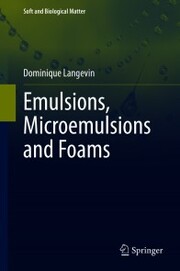Detailansicht
Emulsions, Microemulsions and Foams
eBook - Soft and Biological Matter
ISBN/EAN: 9783030556815
Umbreit-Nr.: 477613
Sprache:
Englisch
Umfang: 0 S., 12.75 MB
Format in cm:
Einband:
Keine Angabe
Erschienen am 21.12.2020
Auflage: 1/2020
E-Book
Format: PDF
DRM: Digitales Wasserzeichen
- Zusatztext
- <p>This book takes an interface science approach to describe and understand the behavior of the dispersions we call emulsions, microemulsions and foams. The one thing all these dispersions have in common is the presence of surface-active species (surfactants) adsorbed at the interfaces between the two fluid phases that make up the emulsions, microemulsions or foams. The interfacial layers formed by the surfactants control most of the properties of the dispersions.</p><p>The book describes the properties of interfacial layers, thin films and bulk fluids used in the elaboration of the various dispersions and it explains how such properties relate to the dispersion properties of these soft matter systems: structure, rheology and stability. These dispersion properties are far from being fully understood, in particular foam and emulsion stability. In discussing the state of the art of the current knowledge, the author draws interesting parallels between emulsions, microemulsions and foamsthat enlighten the interpretation of previous observations and point to a deeper understanding of the behavior of these materials in the future.</p>
- Kurztext
- This book takes an interface science approach to describe and understand the behavior of the dispersions we call emulsions, microemulsions and foams. The one thing all these dispersions have in common is the presence of surface-active species (surfactants) adsorbed at the interfaces between the two fluid phases that make up the emulsions, microemulsions or foams. The interfacial layers formed by the surfactants control most of the properties of the dispersions.The book describes the properties of interfacial layers, thin films and bulk fluids used in the elaboration of the various dispersions and it explains how such properties relate to the dispersion properties of these soft matter systems: structure, rheology and stability. These dispersion properties are far from being fully understood, in particular foam and emulsion stability. In discussing the state of the art of the current knowledge, the author draws interesting parallels between emulsions, microemulsions and foams that enlighten the interpretation of previous observations and point to a deeper understanding of the behavior of these materials in the future.
- Autorenportrait
- <p>Dominique Langevin is CNRS research director. She first worked at the Physics Laboratory of Ecole Normale Superieure in Paris. She was afterwards director of the Paul Pascal Research Center, CNRS laboratory in Bordeaux. She currently works at the Laboratoire de Physique des Solides in Orsay, France.</p><p>Her main research topic is the study of liquid interfaces in the presence of surfactants, polymers and/or nanoparticles, with a special focus on interfacial rheology. She is presently involved in the study of the physical chemistry of foams and emulsions. She published about 400 articles in scientific journals. She is also active in teaching in various area of Physics: Optics, Thermodynamics and topics closer to her research, Formulation, Surfactants and Foams. She received among other awards a grand prix of the French Academy of Sciences, the silver medal of CNRS, the LOréal Unesco award for women in Science and the Overbeek gold medal. She is member of the Academia Europea. </p>
